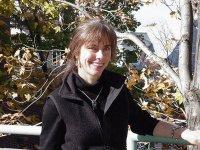Editor’s Note: Alumni and friends in the Los Angeles area, come join us in person as we seminar about The Stories We Tell Ourselves with Rebecca Chamberlain and alumnus Craig Bartlett ’81 on Saturday, February 9th. Learn more and register online today. Below is a guest post from Rebecca to get you ready for the seminar.
Modern wizards of animation have powerful tools to tell stories for today’s world. Craig Bartlett is one of the new storytellers, mixing words and images to tell engaging stories. Popular series, such as Hey Arnold!, inspire and entertain us. Arnold is an unpretentious hero–a model of human goodness, integrity, and resiliency–in complex and demanding world.
Like folktales of old, characters in Hey Arnold! are multidimensional learning from both positive and negative experiences. Plots follow tight story arcs and are seasoned with humor and suspense. Audiences are entertained as they learn vicarious lessons. Traditional storytelling techniques and tools of modern animation come together to create meaningful tales. Some plots draw upon urban legends; others follow the development of various hero types; all speak to important social and cultural issues. I am reminded of a saying by Native American elders in the Puget Sound region, “Stories are the elders way of teaching.”
However, we live in a quickly changing world. Given the social and ecological challenges we face, how is language, story, and technology an evolutionary driver? Richard Louve, in Last Child In the Woods, challenges us to reconnect our lives, and stories, to natural systems. Animated films, such as Miyazaki’s Princess Mononoke (1997), and James Cameron’s, Avatar (2009), use myth and science fiction to explore the relationship between humans, nature, and the cosmos. Can media giants, and modern storytellers, do more to give audiences an authentic understanding, not only of our social relationships, but of our relationship to the earth and it’s natural systems?
Part of the genius of Hey Arnold!, is the flexibility of its episodic narrative structure. Anything can happen. Bartlett’s other series, such as Dinosaur Train, and upcoming science series on Astronomy, function as entertainment, as a way of telling stories about ordinary heroes, and as a way to connect audiences to “big” cosmological stories and narratives. Who are we? Where do we come from? Where are we going? Why are we here? What difference does it make? These questions come back to how we understand the larger stories of our lives, as well as how we create our “Evergreen constellations” of meaning.
I look forward to meeting Craig and our community of Greeners in L. A. to explore “The Stories We Tell Ourselves.” We will ask a number of questions, including: What is the role of the media and technology in developing new communal stories? What are the positive “creative,” aspects of this? What are the challenges? How do stories bring communities together to face important challenges? In what ways might stories become co-opted for commercial or propaganda purposes? What does it take to be a skillful and successful artist, writer, storyteller, and businessperson in today’s media marketplace? What is the role of storytelling in creating a new ecological and cosmological imagination?
Check out following resources:
1) Craig Bartlett’s ‘Hey Arnold!’ episodes on Netflix or YouTube.
2) Chamberlain, Rebecca. “The Power of Story: Words on the Wing,” The Public Sphere Project, Pattern 114. Web. 20 Jan. 2013. < http://www.publicsphereproject.org/node/313>.
From: Liberating Voices! A Pattern Language For Communication Revolution. Ed. Doug Schuler. Boston: MIT Press, 2008. Print.
3) Daddona, Nicole. “Hey Craig! AN INTERVIEW WITH CRAIG FOR HEY ARNOLD FANS // PART 1.” Youtube, 9 Feb. 2012. 20 Jan. 2013. <http://www.youtube.com/watch?v=X9jYfmo9YVc>
__________. “Hey Craig! AN INTERVIEW WITH CRAIG FOR HEY ARNOLD FANS // PART 2.” Youtube, 9 Feb. 2012. 20 Jan. 2013. <http://www.youtube.com/watch?v=AXoN84mW-XU>
4) Princess Mononoke. Dir. Hayao Miyazaki. Studio Ghibli, 1997. Film.
5) Avatar. James Cameron. Twentieth Century Fox, 2009. Film.



Feb. 11, 2012
L.A. Traveling Seminar, Reflections
From: Rebecca Chamberlain
I want to thank everyone for joining us for a stimulating discussion about “The Stories We Tell Ourselves” and “Why?” It was a pleasure to meet such a dynamic, diverse group of individuals. I know we will continue to reflect on questions that were raised, as they impact our personal, professional, and creative lives. We touched upon a number of themes including:
1) The role of myth and cosmology (traditional and modern);
2) Biographical stories, documentary, personal individuation/heroism;
3) The cultural and social role of stories (particularly in creating community
or social change);
4) Stories as entertainment (the artistry and skill of the storyteller; what
makes a good story; the artistic production of stories through words and images in different mediums, particularly animation?)
5) The ecological and technological role of stories (how stories and language serve as evolutionary drivers of human consciousness);
6) Our Evergreen “constellations” of meaning (Evergreen’s pedagogy; the ways we use narrative to create meaning; how we live our stories in the world, and the importance of the liberal arts)?
I’d like to encourage you to post a few lines on our blog at: http://blogs.evergreen.edu/evergreenmind/the-stories-we-tell-ourselves/
Thanks to all for such a warm reception in the L.A. area. I’d like to close a special “thanks “to Craig Bartlett for being one of the storytelling magicians of our age, and for his skill in telling stories that inspire and transform lives.